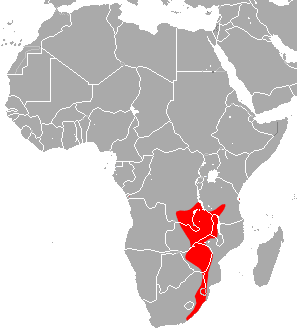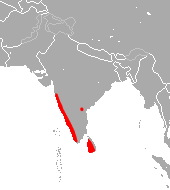
Horseshoe bats are bats in the family Rhinolophidae. In addition to the single living genus, Rhinolophus, which has about 106 species, the extinct genus Palaeonycteris has been recognized. Horseshoe bats are closely related to the Old World leaf-nosed bats, family Hipposideridae, which have sometimes been included in Rhinolophidae. The horseshoe bats are divided into six subgenera and many species groups. The most recent common ancestor of all horseshoe bats lived 34–40 million years ago, though it is unclear where the geographic roots of the family are, and attempts to determine its biogeography have been indecisive. Their taxonomy is complex, as genetic evidence shows the likely existence of many cryptic species, as well as species recognized as distinct that may have little genetic divergence from previously recognized taxa. They are found in the Old World, mostly in tropical or subtropical areas, including Africa, Asia, Europe, and Oceania.

The lesser horseshoe bat is a type of small European and North African insectivorous bat, related to its larger cousin, the greater horseshoe bat. As with all horseshoe bats, the species gets its name from its distinctive horseshoe-shaped noseleaf.

Adam's horseshoe bat is a species of bat in the family Rhinolophidae. It is endemic to Republic of the Congo. It roosts in caves.

The intermediate horseshoe bat is a bat species of the family Rhinolophidae that is very widespread throughout much of the Indian subcontinent, southern and central China and Southeast Asia. It is listed by IUCN as Least Concern as it is considered common where it occurs, without any known major threats.

Blasius's horseshoe bat is a species of insectivorous bat in the family Rhinolophidae found throughout large parts of the Mediterranean, Middle East and Africa.

The Bornean horseshoe bat is a species of bat in the family Rhinolophidae. It is found in Brunei, Cambodia, Indonesia, Laos, Malaysia, and Vietnam.

The Andaman horseshoe bat is a species of bat in the family Rhinolophidae. It is endemic to the Andaman Islands. During the day, it roosts in caves, but may also choose tree hollows.

The convex horseshoe bat is a species of bat in the family Rhinolophidae. It is found in Malaysia and Laos.

Darling's horseshoe bat is a species of bat in the family Rhinolophidae found in Africa. Its natural habitats are dry savanna, caves and other subterranean habitats.

Decken's horseshoe bat is a species of horseshoe bat. It is found in Kenya and Tanzania. Its natural habitats are tropica and subtropical moist lowland and montane forest, moist savanna, caves and other subterranean habitats.

Blyth's horseshoe bat is a species of bat in the family Rhinolophidae. It is found across southern Asia from Afghanistan to Vietnam. The species can be identified from its pointed, bifid sella.

The big-eared horseshoe bat is a bat species within the Rhinolophidae native to Asia.

The smaller horseshoe bat is a species of bat in the family Rhinolophidae. It is found in Australia and Papua New Guinea.

Mehely's horseshoe bat is a species of insectivorous bat in the family Rhinolophidae found in Southern Europe and parts of the Middle East. It is distributed in a narrow band around the Mediterranean Sea from North-Western Africa across Portugal, Spain, the Balearics, southern France, Sardinia, Sicily and the Balkan Peninsula to Asia Minor.

The lesser woolly horseshoe bat is a species of bat in the family Rhinolophidae. It is found in Brunei, Indonesia, and Malaysia. It is assessed as near-threatened by the IUCN.

Swinny's horseshoe bat is a species of bat in the family Rhinolophidae. In English, R. swinnyi is commonly referred to as Swinny's horseshoe bat. In Afrikaans, it is commonly referred to as Swinny se saalneusvlermuis. This species belongs to the African clade. R. swinnyi was discovered by an African collector H. H. Swinny. They have been recorded in Angola, Republic of the Congo, Mozambique, South Africa, Tanzania, Zambia, Zimbabwe, and Malawi.
The Yaeyama little horseshoe bat is a species of bat in the family Rhinolophidae that is endemic to the Yaeyama Islands of Japan.

















